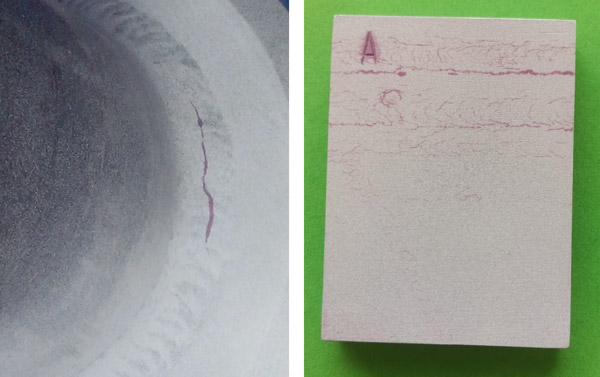I. Introduction
Penetration testing is one of the five conventional nondestructive testing methods. Dye-penetrant inspection is a kind of penetrant inspection, which is easy to operate, easy to carry, intuitive to display defects, has high sensitivity, and is suitable for the detection of various complex working conditions.
II. Fundamental principles
Using the capillary phenomenon, when testing, first let the permeate infiltrate the defect, and then use the cleaning agent to remove the excess permeate on the surface of the workpiece. At this time, there will be residual permeate in the defect, and then the capillary action of the imaging agent is used to adsorb the residual permeate in the defect to achieve the purpose of inspecting the defect.
III. Operating steps
Dye-penetrant inspection is mainly divided into 5 steps: pre-cleaning, color penetration, cleaning and drying, development, observation.
1. Pre-cleaning
Before applying penetrant on the surface to be inspected, the surface of the workpiece should be cleaned with a cleaning agent, so that the surface of the workpiece is free of oil, rust, paint and other contaminants.Wait until the cleaning agent evaporates cleanly, so that the surface of the tested material remains dry.
2. Color penetration
The surface of the cleaned workpiece is sprayed evenly with penetrant and permeated for 5-15 minutes. The surface of the workpiece is kept wet during the permeation time.
3. Cleaning and drying
After penetrating for 5-15 minutes, before applying the developer, use the cleaning agent to spray on the non-woven fabric, use the non-woven fabric to wipe the penetrant on the surface of the workpiece, and keep the surface of the workpiece clean and dry.
Precautions: When cleaning excess penetrant, avoid over-cleaning or under-cleaning.
4. Development
After the developer is fully shaken, spray evenly on the workpiece surface at a distance of 15-500px, with a spraying angle of 30°-40°, and the development time is not less than 7 minutes.
5. Observation
Observe the developing trace from the application of the developing agent until the size of the developing trace does not change. The observation period must be carried out in sufficient natural light, generally not less than 1076Lux, confirmed by visual or 5-10 magnifying glasses.
IV. Application examples




